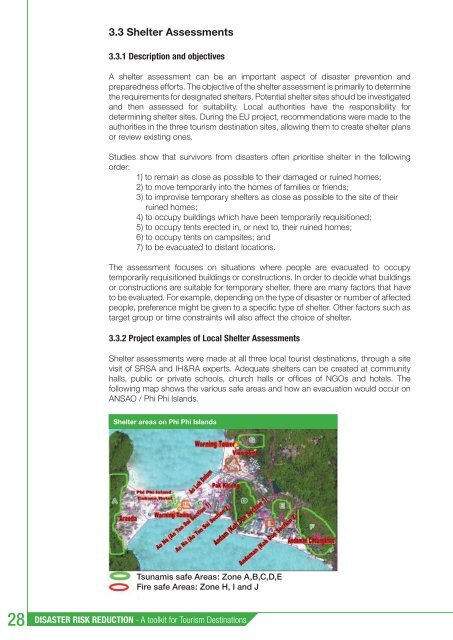Disaster Risk Reduction - A Toolkit for Tourism ... - PreventionWeb
Disaster Risk Reduction - A Toolkit for Tourism ... - PreventionWeb
Disaster Risk Reduction - A Toolkit for Tourism ... - PreventionWeb
You also want an ePaper? Increase the reach of your titles
YUMPU automatically turns print PDFs into web optimized ePapers that Google loves.
3.3 Shelter Assessments<br />
3.3.1 Description and objectives<br />
A shelter assessment can be an important aspect of disaster prevention and<br />
preparedness ef<strong>for</strong>ts. The objective of the shelter assessment is primarily to determine<br />
the requirements <strong>for</strong> designated shelters. Potential shelter sites should be investigated<br />
and then assessed <strong>for</strong> suitability. Local authorities have the responsibility <strong>for</strong><br />
determining shelter sites. During the EU project, recommendations were made to the<br />
authorities in the three tourism destination sites, allowing them to create shelter plans<br />
or review existing ones.<br />
Studies show that survivors from disasters often prioritise shelter in the following<br />
order:<br />
1) to remain as close as possible to their damaged or ruined homes;<br />
2) to move temporarily into the homes of families or friends;<br />
3) to improvise temporary shelters as close as possible to the site of their<br />
ruined homes;<br />
4) to occupy buildings which have been temporarily requisitioned;<br />
5) to occupy tents erected in, or next to, their ruined homes;<br />
6) to occupy tents on campsites; and<br />
7) to be evacuated to distant locations.<br />
The assessment focuses on situations where people are evacuated to occupy<br />
temporarily requisitioned buildings or constructions. In order to decide what buildings<br />
or constructions are suitable <strong>for</strong> temporary shelter, there are many factors that have<br />
to be evaluated. For example, depending on the type of disaster or number of affected<br />
people, preference might be given to a specifi c type of shelter. Other factors such as<br />
target group or time constraints will also affect the choice of shelter.<br />
3.3.2 Project examples of Local Shelter Assessments<br />
Shelter assessments were made at all three local tourist destinations, through a site<br />
visit of SRSA and IH&RA experts. Adequate shelters can be created at community<br />
halls, public or private schools, church halls or offi ces of NGOs and hotels. The<br />
following map shows the various safe areas and how an evacuation would occur on<br />
ANSAO / Phi Phi Islands.<br />
Shelter areas on Phi Phi Islands<br />
Tsunamis safe Areas: Zone A,B,C,D,E<br />
Fire safe Areas: Zone H, I and J<br />
28<br />
DISASTER RISK REDUCTION - A toolkit <strong>for</strong> <strong>Tourism</strong> Destinations

















